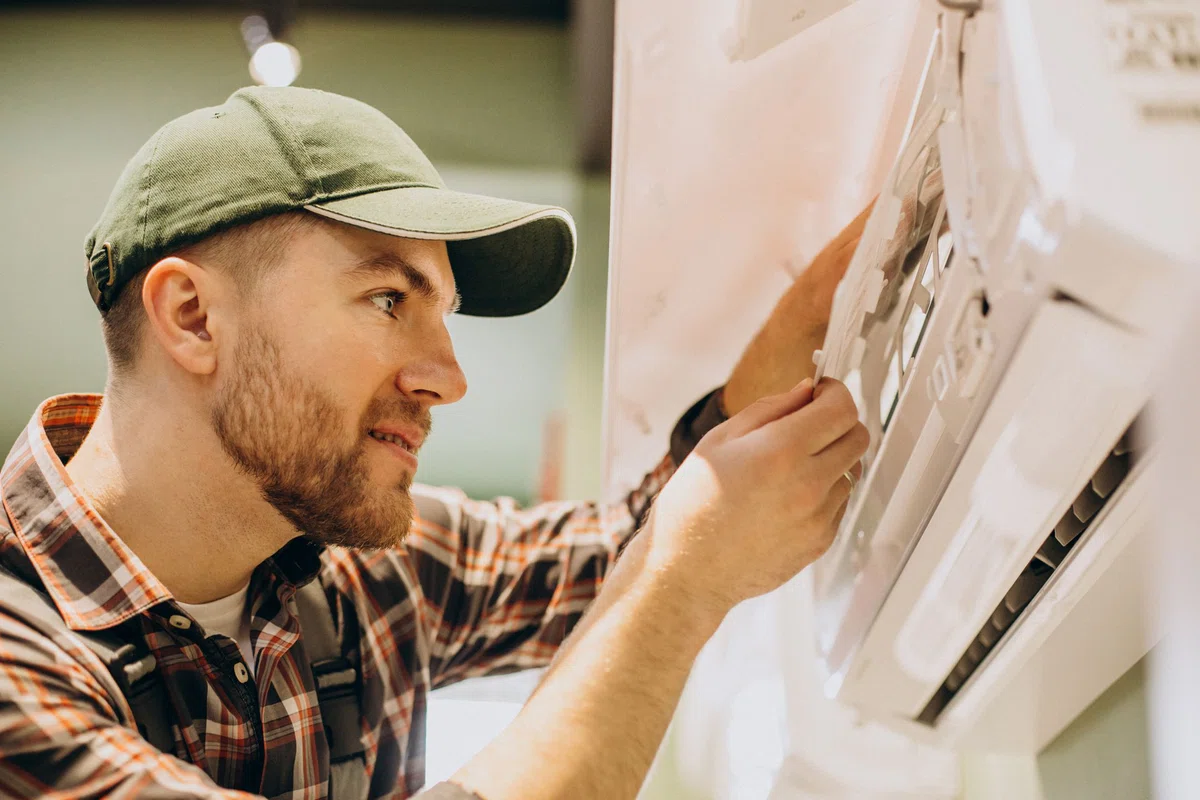
Eliminating Screeching Doors: Causes, Methods, and Professional Solutions
Learn how to fix squeaky doors without the hassle. Wear of hinges, swelling of a wooden sheet - we will talk about the causes and effective methods of elimination. Leave the care of door problems to professionals or use new technologies. Here you will find tips and tricks from experts to make your door quiet and smooth. Visit our website and find out more!
Content
- Cleaning the air conditioner indoor unit
- Cleaning the outdoor unit
- Frequently asked questions
- How often should I clean my split system? 🧹
- What equipment will I need for cleaning? 🛠️
- What part of the split system should I clean? 🌬️
- How do I clean filters safely? 😷
- What to do if you are not confident in your skills? 🤔
- What are the benefits of cleaning a split system? 💨
To ensure longer service life of split-system, to prevent mold formation on filters and avoid inhalation by it, it is necessary to clean air conditioner - both internal and external unit - regularly.
We will tell you in what situations you can clean air conditioner with your own hands, how to do it at home, and when it is better not to risk and call a specialist.
Cleaning of the internal unit of the air conditioner
Cleaning of the split-system internal unit is an important stage of regular maintenance of the air conditioner. In most instructions it is recommended to clean filters at least twice a season - in spring, before regular use of the air conditioner, and in fall, before its shutdown for winter. In this article we will tell you in detail about the process of cleaning the indoor unit, give useful tips and new interesting information.
Before starting the cleaning procedure it is necessary to disconnect the split-system from the mains to avoid possible electric shock. After disconnection, inspect the case from the outside and pay attention to the presence of cracks or chips. Particular attention should be paid to the bottom part where leaks may occur. If the drain tubes are clogged and moisture is not being removed properly, the air conditioner drain system may need to be repaired. It is also necessary to diagnose if there are cracks on the case, which may have occurred due to overheating or shock.
It is important to remember that independent repair of the air conditioner without special knowledge can lead to its damage. Therefore, it is recommended to call a master and entrust this work to him.
After inspection and necessary repair works, you can start cleaning the internal unit of the air conditioner. Before starting, it is recommended to protect the floor and walls from dirt, dust and splashes.
- For this purpose, you can use polyethylene film, which can be purchased in building stores. The polyethylene film should be placed on the floor and wrapped around the air conditioner so that the unit remains outside and the walls are under the film. The edges of the film can be attached with scotch tape or painter's tape, which can be easily removed from the wallpaper and does not damage it.
- You can also use a special cover for collecting and draining water on the air conditioner, which will help prevent flooding of the floor and inconvenience to neighbors. Such covers can be purchased in online stores specializing in goods for home and repair.
Before disassembling the indoor unit, it is necessary to read the manual corresponding to your air conditioner model and prepare a screwdriver.
- Usually the outer box and the louvers near the air inlet are secured with plastic latches, so be careful not to damage the latches when disconnecting the parts.
- The inner parts are most often fastened with self-tapping screws. In some models it is necessary to remove all parts, including the unit with electronics and fan, and in others it is enough to remove only the housing and filter. In the case of removing the fan, it will have to be washed on the wall. If the electronics box on your model is not removable, it should be wrapped in foil to prevent moisture from getting inside.
Cleaning of the air conditioner's indoor unit starts with dust removal. It is recommended to use a vacuum cleaner and a stiff brush for this purpose. Skipping this step may lead to wet dust clogging in the crevices, which will complicate its subsequent cleaning.
Next, wash the housing and filters with soap and water. It is not recommended to wash plastic parts in hot water, as they may deform. If the filters are heavily soiled, they can be wiped with a dishwashing sponge.
After cleaning, it is recommended to disinfect the air conditioner with a special antiseptic designed for split-systems. Such means can be purchased in construction hypermarkets. Disinfection will help to get rid of mold and prevent its reappearance. It is important to note that antiseptics for hands are not suitable for this purpose, as they can leave a sticky deposit, on which dust will accumulate faster.
After applying the antiseptic, you should give it time to take effect. It is recommended to wait at least half an hour before the next step. It is then necessary to flush the antiseptic with water. Flushing the system from disinfectant compositions is difficult to perform with a rag, so it is recommended to use a garden sprayer, which can be purchased in construction stores.
After flushing, you should let the liquid drain and dry the parts. It is recommended not to turn on the air conditioner for at least a day. After that you can assemble the indoor unit and start the device.
Cleaning the outdoor unit of the air conditioner
Cleaning your split system's outdoor unit is an important procedure to maintain its efficiency and long life. Here are some additional tips and interesting information related to cleaning the outdoor unit of an air conditioner.
The frequency of cleaning the outdoor unit depends on its installation floor:
- In a private house or on the 1st to 4th floor of an apartment, the outdoor unit should be cleaned twice a year: in the spring before the system starts up and in the fall before shutting down for the winter. The lower the floor, the more dust and dirt accumulates in the outdoor unit.
- For apartments on 5-8 floors, it is enough to clean once every 2-3 years, as there is less dust, but insects can get into the unit.
- In apartments located above the 9th floor, cleaning can be done once every 3-4 years, as the air on the upper floors is cleaner.
It should be noted that residents of private houses and apartments on the first floor can clean the unit themselves using a stepladder. However, if you live on the second floor or higher, it is not recommended to perform this task yourself, even if the unit is installed directly under your window. In such cases, there is a risk of falling out of the window and getting injured. If you don't have access to the outside unit or don't have the proper equipment, it is recommended that you call a professional handyman to do the job. They have the necessary knowledge and equipment to carry out the cleaning safely.
- Use dust and dirt protection: In addition to regular cleaning, special protective covers or covers can be installed on the outdoor unit. These accessories prevent dust, leaves, insects and other contaminants from entering the unit, reducing the need for frequent cleaning. They are easily removable and washable, making it easy to care for the system.
- Check the condition of the seals and insulation: Regularly inspect the rubber gaskets and insulation around piping that passes through a wall or window. Make sure they are in good condition and are not cracked or damaged. Replace seals and insulation as necessary to prevent air, dust and moisture from entering.
- Use specialized cleaners and antiseptics: When cleaning the outdoor unit, you can use specialized cleaners designed specifically for air conditioners. They ensure effective removal of dirt, dust and mold and prevent their reappearance. Such products can be purchased in stores specializing in the sale of climate control equipment.
- Check fasteners and safety features: When cleaning the outdoor unit, pay attention to the condition of the fasteners and safety features. Make sure that all bolts and fasteners are securely fastened and have no visible damage. Also check for a net or safety screen to prevent foreign objects from entering the unit's vents.
- Have the system professionally serviced: In addition to regular self-cleaning, it is recommended to call a professional craftsman for a complete maintenance of the split system. The specialist will perform a detailed inspection and cleaning of all components, including the outdoor unit, check compressor operation, refrigerant level and other important parameters, and will be able to detect and repair possible malfunctions and leaks.
- Observe safety when working on the air conditioner: When performing any cleaning or maintenance work on the outdoor unit of the air conditioner, be sure to observe safety precautions. Unplug the unit before starting work, use a ladder or stepladder that is securely fastened, and do not attempt to work at high heights without proper equipment and experience. If you are not sure of your skills or the safety of the work, it is better to call a professional.
Frequently Asked Questions
How often should a split system be cleaned? 🧹
It is recommended to clean your split system at least every six months to keep it running efficiently.
What equipment will I need for cleaning? 🛠️
You will need a mask or respirator, gloves, a soft-bristled brush, a vacuum cleaner, water and a gentle detergent solution for cleaning.
What part of the split system should I clean? 🌬️
The filters of the indoor unit, the outdoor unit should be cleaned of dust and dirt, and the air conditioner's duct system should be cleaned.
How to clean the filters safely? 😷
Remove the filters from the indoor unit, rinse them with warm water and mild detergent, let them dry and put them back in.
What to do if you are not confident in your skills? 🤔
If you have doubts or uncertainty, it is better to contact professionals who will perform split system cleaning safely and efficiently.
What are the benefits of split system cleaning? 💨
A clean split system provides fresher and healthier indoor air, increases the efficiency of the system and improves its lifespan.







22 comments
Log in to leave a comment